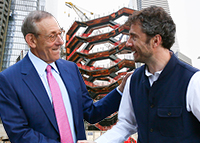The suicide Saturday at Hudson Yards added the complex’s Vessel to the list of popular attractions in New York City where people have taken their own lives.
At about 6 p.m. Saturday, a 19-year-old man jumped to his death from the 150-foot Vessel, a busy tourist destination where a chest-high barrier is all that separates the platform from the edge.
The Empire State Building, the George Washington Bridge and the subway system have become known as “suicide magnets” — places that, for one reason or another, seem to attract suicides.
“It is in part about the media. The media report on these so frequently because they tend to be a bit unusual in terms of the method of death,” explained Dr. Daniel Reidenberg, executive director of the advocacy group Suicide Awareness Voices of Education. “And that will drive people to those places.”
Read more


Reidenberg said that while leaps from high places account for only about 2 percent to 3 percent of suicides, the publicity they attract is a big factor in attracting people who are thinking about killing themselves.
“Most of the time people choose a method that is most accessible for them — what seems to be most readily available” he added. Roughly one person per week attempts suicide by venturing onto the subway tracks from one of the system’s 472 stations.
Reidenberg pointed out that there are plenty of cases in which someone goes to a tall building or a bridge intent on suicide, then decides against it. In fact, he said, some choose such a location because they are having second thoughts.
“Oftentimes, people think somebody will stop them along the way,” he said.
A spokesperson for Thomas Heatherwick, who designed the Vessel, said the designer’s studio is “deeply saddened to hear this tragic news and sends deepest condolences to the family of the man who lost his life on Saturday evening.”
Representatives for Hudson Yards developer the Related Companies did not respond to requests for comment.
As of Monday, no netting or new barriers appeared to have been put in place on the decorative architectural structure on the Far West Side — a measure that other sites have had to consider.
The Empire State Building, where dozens have taken their lives since the iconic building opened in 1931, has a suicide barrier around its observation deck. At the George Washington Bridge, the Port Authority of New York and New Jersey began installing an 11-foot-high barrier in 2017 following multiple suicides.
The family of one woman who plunged to her death from the bridge in July 2017 sued the Port Authority the following year, claiming the agency knew the bridge attracted jumpers and should have done more to put preventive barriers in place. A Manhattan Supreme Court judge ruled in favor of the agency.
“Property owners are not held to have the duty of a mental health profession,” Judge Arlene Bluth wrote. “Most property owners have no idea about the mental state of people who traverse their properties. They cannot be held liable because someone makes the tragic decision to take her own life.”
The judge did refer to a similar, federal court case regarding a Cornell University student who leapt to his death from a bridge in Ithaca. The judge in that case found neither the college nor the city liable, but opine that while they could not have predicted the student’s action, it was “clearly foreseeable that someone” might jump from the bridge.
Perhaps the best-known controversy about suicide barriers has been at San Francisco’s Golden Gate Bridge, where a decades-long debate led to a $211 million project that began in 2017. It is slated for completion in 2023.
Some argued that the project would mar the appearance of the historic bridge and questioned whether it would prevent suicides or just move them to other locations. More than 1,000 people are estimated to have jumped from the bridge since it opened in 1937. Only a few dozen are believed to have survived.
Those who are having thoughts of suicide are encouraged to call the National Suicide Prevention Lifeline at 1-800-273-8255 (TALK) or contact the Crisis Text Line at 741-741.
